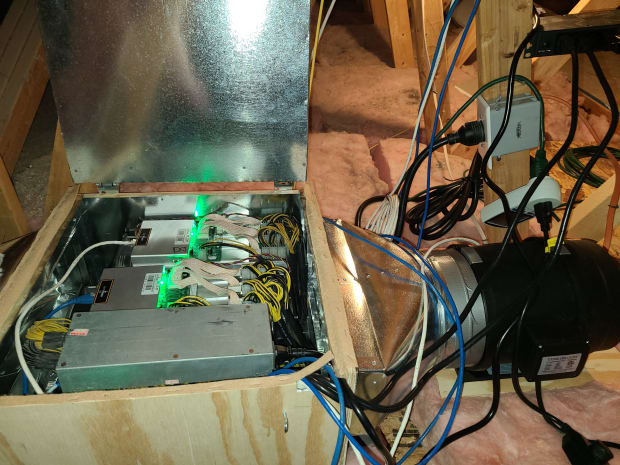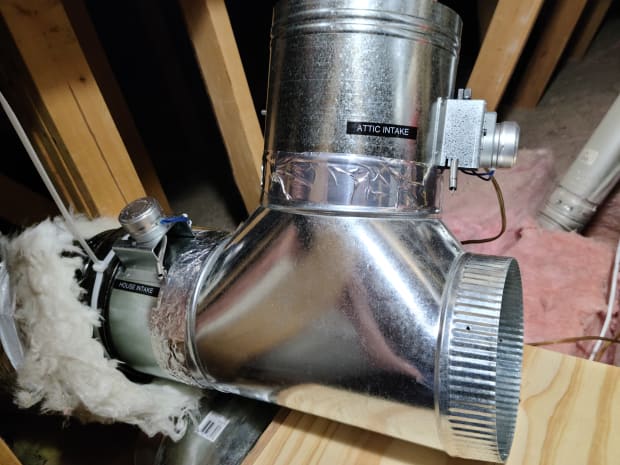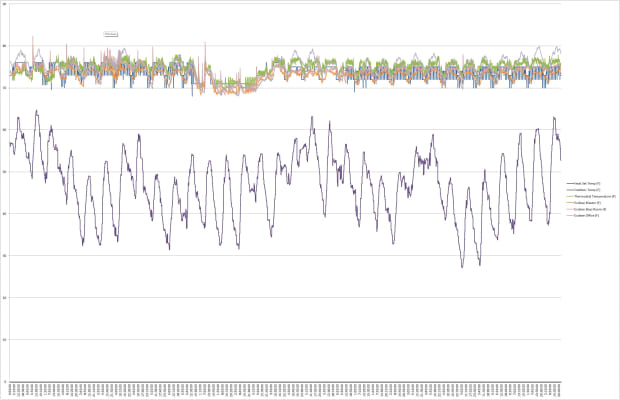Blogs & Articles: Tech Engineer Shares His Sats-Earning, DIY Home Heating System 🔗 2 years ago

- Category: Blogs & Articles | Bitcoin Magazine: Bitcoin News, Articles, Charts, and Guides
- Author(s): Captain Sidd
- Published: 1st February 2022 23:00
A home bitcoin miner shares details on how he earns bitcoin while heating his home with a DIY ASIC setup.
This piece is part of a series that features interviews with Bitcoin miners about their experiences setting up and scaling mining operations, as well as their views on the direction of the mining world. If you are mining Bitcoin and want to share your knowledge and story — the ups, downs and innovations — reach out to the author on Twitter @CaptainSiddH. I met my interviewee for this piece, @TechEngineer21, because he reached out!
For this interview, TechEngineer21 went over his simple yet powerful home heating system. I hope this system can be an inspiration for hobbyists, since it doesn’t require a big budget or sophisticated knowledge and tools to assemble yourself. With just three S9 miners, TechEngineer21 no longer needs to use his gas furnace to heat his home. He shared a mountain of data collected by his smart home system and a full walkthrough of how his heater operates. You can find TechEngineer on Twitter (@TechEngineer21) and YouTube (Tech Engineer).
Thanks for joining us for this series on home mining! I’ve followed you a bit on Twitter where you’re sharing your mining setup. Can you walk us through the steps you took to design and build the Bitcoin miner-based heating system you have now?
It all started back in 2017 when I was first considering buying a miner. I was living in Colorado at the time, and I knew this thing would make a lot of heat and use a lot of energy. I wanted to somehow harness that heat to heat my house. Originally, my plan was to put the miner in the basement and have some ductwork going up through the vent and into my house.
I never ended up getting the miner back then, just because it was hard to get them at that time. But that idea stuck in my head: If I mine, I want to somehow harvest the waste heat so that I'm not just consuming a ton of energy for maybe a little bit of profit. 2020 came around and I wanted to get back into this. The perspective of helping secure the Bitcoin network as a whole was newly implanted into my mind around this time as well.
I started sketching out an airflow diagram on the whiteboard. I work in data centers a lot, so I knew about the concept of a hot and cold aisle. Translating that idea to my home, I would pull in cool air through the miners and then spit it out into a hot aisle; in this case, my home. I just needed to figure out a way to enclose the miners in something and then push or pull air through it.
I designed a box around three Antminer S9s. I chose S9s because they're affordable, and I could get them. I wasn't ready to make a commitment of $10,000 to $30,000 for S19s. Once I finished the box, I ran the miners in there with an extra fan — and they ran well. I put that box up in my attic and connected it into my ducting. I had it working manually, so I'd have to take it off manually when the house was hot and put it back on when I needed more heat.
 The box with three S9s tucked inside, grafted into the home’s ducting. Source: TechEngineer21.
The box with three S9s tucked inside, grafted into the home’s ducting. Source: TechEngineer21.
In my whiteboarding, I also sketched out a way to control this airflow. I knew I needed a valve of some sort to change the intake and exhaust for the miner box. At first, I was looking for something like a butterfly valve. Turns out those are for hydraulics, and they're really expensive. Finally, I stumbled upon these dampers which run on 24 volts, the same as my thermostat’s output. Perfect. Now, the miners are stage one of my heater, and the thermostat puts out a 24 volt message that changes the dampers to control the flow of air.
 The attic intake with damper control module shown. Source: TechEngineer21.
The attic intake with damper control module shown. Source: TechEngineer21.
I love your setup because it’s ingenious and simple. Reusing heat from home miners can get pretty complex pretty fast, but your setup is simple yet very practical. You have a box, a thermostat and some dampers. What was your process to find and buy the miners that you're using?
I bought them on eBay. I looked at Bitmain and other websites, but I was never able to get a hold of a machine directly from any manufacturer. I'd also kind of done some research on the profitability of miners and I knew that S9s were just barely at the breakeven point. Here in Nevada where I’m at, the electricity rates are extremely low. And I'm also on a special electricity plan that makes electricity about 7 cents a kilowatt hour. That makes a big difference. Otherwise, profitability would be a completely different equation.
With S9s treading along the borderline of profitability, I knew that if I could make them work as a heater, that would change the profitability calculation. I've got some data now, so I can see that my miners are borderline above profitable — before considering savings on the energy bill. I’m basically getting my miners to heat my house for free while maybe making quite a bit more depending on the price of bitcoin. Who wouldn't want to heat their house for free?
I want to go back to the power cost you mentioned. Can you walk through what agreement you have with the power company and how you got that?
It's called “time of service billing.” They have it here in Nevada and possibly other places around the country. What they're doing is incentivizing less usage of electricity during high demand times — think between 1:00 p.m. and 7:00 p.m. during the summer months.
Normally, the energy price here is around 12 cents per kilowatt hour year round. With time of service billing, electricity during that peak time window in the summer costs me something like 45 cents per kilowatt hour. However, during the rest of the year, they will sell you power at around 7 cents per kilowatt hour. As long as you're willing to figure out how to reduce your energy load during the peak demand or shift that consumption to low demand times, you can save a lot of money.
Cities need to offer programs like this because they don't want to build a new power plant just to be able to power that one time frame, from 1:00 p.m. to 7:00 p.m. over the summer, when everybody is running their AC. Cities and power companies thus try to incentivize the stabilization of the power grid over time by offering this variable pricing. I discovered this program in my area when I was getting solar power with battery backups installed. In my case, I'm able to actually sell power back to the grid during that peak time, so I can really make it work to my advantage.
So, I have to ask: How do you get by having AC in the summer? Do you just go without it, use solar power or pay the higher energy price?
What I do is pre-cool my house until 1:00 p.m. by setting the thermostat a bit cooler. The house will stay cooler for a while as the temperature outside rises. If the AC is needed, I have the batteries that kick in. From 1:00 p.m. to 7:00 p.m., I use zero power from the grid, and actually sell back power from my solar panels.
I’ve heard you use the phrase “double spending your energy.” Can you walk us through the numbers on your energy bill and show how much money your miners are saving you?
Absolutely. First off, let me start with this: double spending my energy bill comes from the fact that when you're using electricity, 100% of that electricity gets turned into heat, all the time. It doesn't matter what it is. It doesn't matter if it's a light bulb, or your refrigerator or your TV monitor. All that electricity that's consumed in your house will end up as heat in your house. I didn't know that for a long time.
If it's a 6-watt bulb, it's a 6-watt heater. That's where double spending comes from, because it's 100% efficient. You're getting bitcoin and then you’re also getting all the heat.
The data from my Ecobee smart home device shows the capability of three S9 miners to heat my home. This graph (below) shows a month of data. You can see the temperature spikes, the highs and lows of each day. The lowest we ever got to was about 28 degrees. The miner heating system kept the house at the setpoint, with my main furnace running only a couple of hours throughout the entire month. Actually, that's because I hadn't quite tuned the system correctly.
 Purple line is the outdoor temperature, while the many lines above record the temperature within individual rooms of the house, as well as the thermostat programmed temperature (blue). Source: TechEngineer21.
Purple line is the outdoor temperature, while the many lines above record the temperature within individual rooms of the house, as well as the thermostat programmed temperature (blue). Source: TechEngineer21.
As for the financials, I do have an Excel spreadsheet of my numbers here that I can show. I took the overall energy used during the same time period in different years. Last year — when I wasn’t doing any mining — I used 1,100 kilowatt hours. This year with miners on, I used almost 5,000 kilowatt hours. I calculated the cost to run my three Antminer S9s based on 24/7 operation, which came out to $253. My total electricity bill last year was just $77, versus $348 for this year with $270 of that due to the miners. However, my natural gas consumption is down from 64 therm to 24 therm this year, decreasing costs there.
I also mined 0.0077 bitcoin in that 31 day period. Taking that, times $43,000, which is around the current price today, gives me a fiat equivalent of $335. Subtract that from my energy bill, and I’m looking at just $32 in costs for the entire month. Last year, the total energy bill came out to $134, so I had a total savings of $101 — over 75% cut in my energy bill.
In Nevada, energy costs are extremely low in general. There are a lot of places in the country with higher costs where heating appliances aren’t paying their owners anything. Why wouldn't you want to switch from electric heating to ASIC miner heating?
Heat reuse clearly works well in the winter. How will your system handle the summer months? Will you need a cooling solution?
My plan tentatively for the shoulder seasons like fall and spring is to reverse the airflow — pull in from the house and vent to the attic. That would work when the temperature is relatively cool, not above say 75 degrees. In the summer, I'll probably end up just putting the miners in my garage. Nevada is probably the worst testbed for this system to be honest, because it's the desert, but I was still interested enough to do it. I want to get into submersion cooling next, which has a lot of applications too.
What about noise? Can you hear your miners in the house, since they are connected to your ductwork?
I’d say it’s 98% silent. I can tell it's on because I know it's there, but if you didn't know you’d just think it was a regular heater. It’s not even as loud as the regular heater. The box the miners are housed in cuts a lot of noise, plus the insulation in the attic. The bends in the ducting baffle the sound as well, so not much noise makes it into the house.
Are you considering commercializing your setup as an HVAC heating unit?
I decided just to release my system in a video because the more I thought about it, I didn't really think it was viable to bring to market yet.
I would like to see this technology brought to non-Bitcoiners, and I feel that collaborating with other people in the space will speed up the development process for the community in general. I definitely am considering some sort of product in the future, but I don’t see the one I built for my own home as a viable product in its current state.
What advice do you have for people thinking about getting into mining?
Do a lot of research. Start with trying to understand how Bitcoin works, how encryption works, the mining process, the difficulty adjustment. I think one of the biggest pitfalls people get sucked into right off the bat is looking at a profitability calculator online. You see an S19 makes $100 a day. That looks amazing, its ROI is like three months. However, these rarely take into account the difficulty increasing over time, or the price of bitcoin changing over time.
Number one is do your own research, but then just jump in. There is little to lose. Have fun with it.
I really appreciate you taking the time to share your home heating system and vision for the future with me. Best of luck with commercializing an even better system!
If you want to reach Tech Engineer, he’s on Twitter @TechEngineer21. He also shares a breakdown of his entire heating system build and data he collected on his YouTube channel.
This is a guest post by Captain Sidd. Opinions expressed are entirely their own and do not necessarily reflect those of BTC Inc or Bitcoin Magazine.











